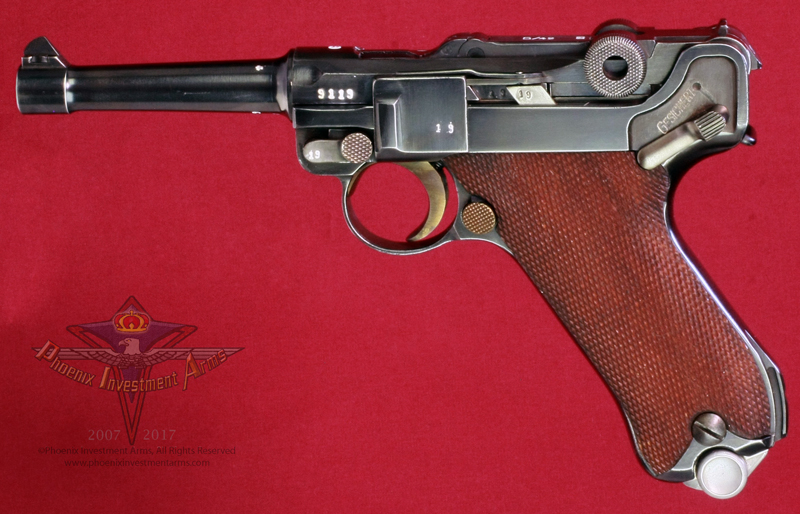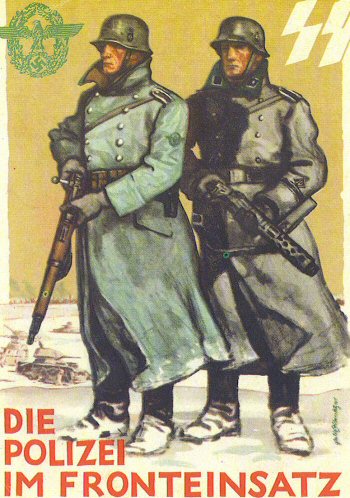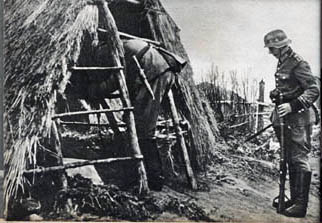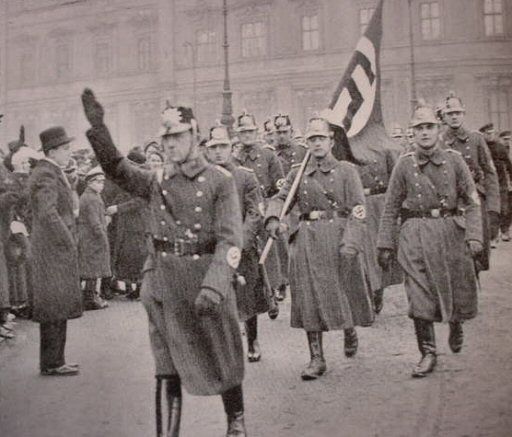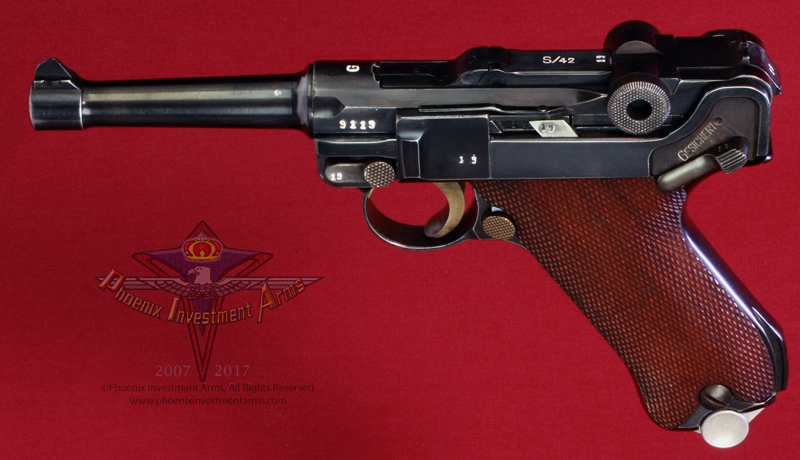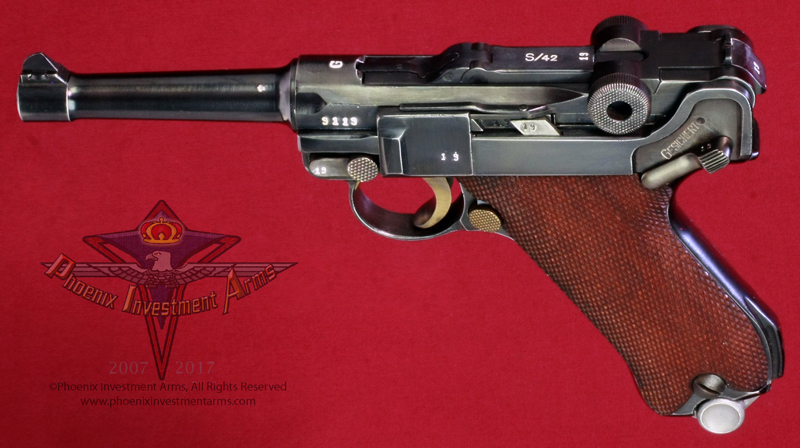 |
|
This is a very rare all-matching Mauser G-Date S/42 Police rig with two matching magazines and is proofed with the Eagle 63 proof, and the sear safety as was issued to the German police. This example has all matching numbers. This is a complete rig as taken from the battlefield with the gun, 1935 dated Police holster, 2nd magazine, proofed loading tool, belt & early steel police buckle. Noted authors place the procurement of the G-Date Police as less than 600 Parabellum making this a highly desirable for the early police collector. (1940) |
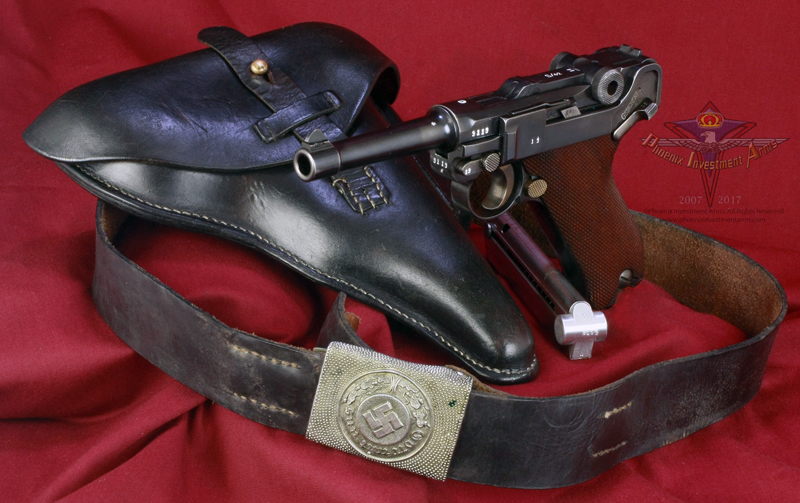 |
NOTE: Photographs taken today
with the high mega-pixel camera show more than we sometimes can see with
the human eye. Magnified close-ups show us tool marks and natural
surface conditions that one normally doesn't see in the ordinary
handling of the weapon. Photographs are
copyrighted, all rights reserved, any extraction, reproduction or
display of gun pictures without the express consent of the Phoenix
Investment Arms is strictly prohibited. Thank you for your cooperation.
Please read "Legal"
for all the terms of the sale. |
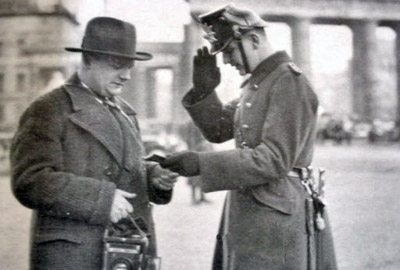 |
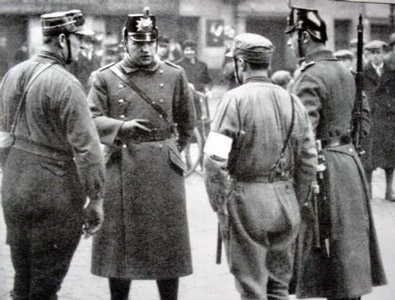 |
|
German Police [Polizei] provided all the ordinary police work from traffic control, checking identities and supplemented with police reservist people control. |
|
|
|
|
|
This Parabellum is 9mm police gun in a 100mm barrel length with all matching serial numbers to include matching, original grips. Serial number placement is in the military ("exposed") style. The thumb safety is marked 'Gesichert' and safe is thumb down and the extractor is marked "Geladen" (Loaded). The barrel is numbered and proofed and matches the frame. The bore is good with distinctive lands and groove. The thumb safety is new style, and blued. Over the sear above the side plate is the sear safety that designates this gun a police mode. |
|
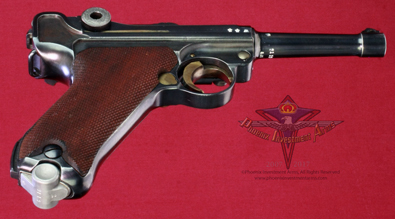 |
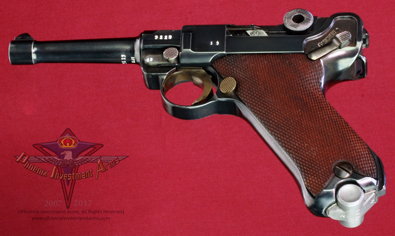 |
 |
|
|
Mauser-Werke and Berliner-Karlsruher Industrie-Werke (BKIW), [BKIW was the successor to DWM (Deutsche Waffen und Munitionsfabriken)] had common ownership. In 1930 the machinery, technicians and supplies were moved from Berlin-Wittenau to Oberndorf and BKIW's interest in the Parabellum ceased. There is a "V" notched rear sight and stock lug. |
|
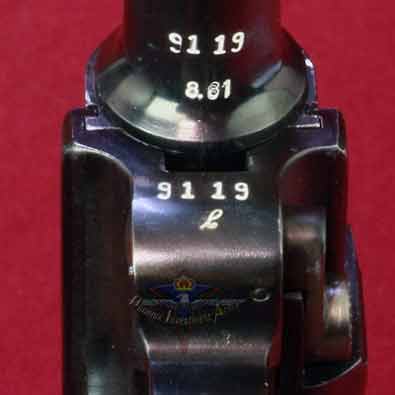 |
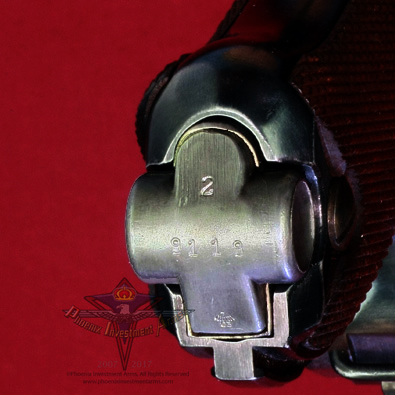 |
Serial number placement is
standard military; front frame, under the barrel, the side plate, the extractor,
the safety, the sear bar retaining pin and the majority of the internal
parts are serial numbered. The Mauser Code S/42 appears on the fist toggle link and
the "V" cut rear sight and last two digits of the serial number appear on
the rear toggle. Magazines are steel wrapped and crimped with aluminum bottoms and the droop wing Eagle 63 proof. The number on the toe of the magazine (1 or 2) representing the number of the magazine some going to 4 when the double ammo pouch is added. |
|
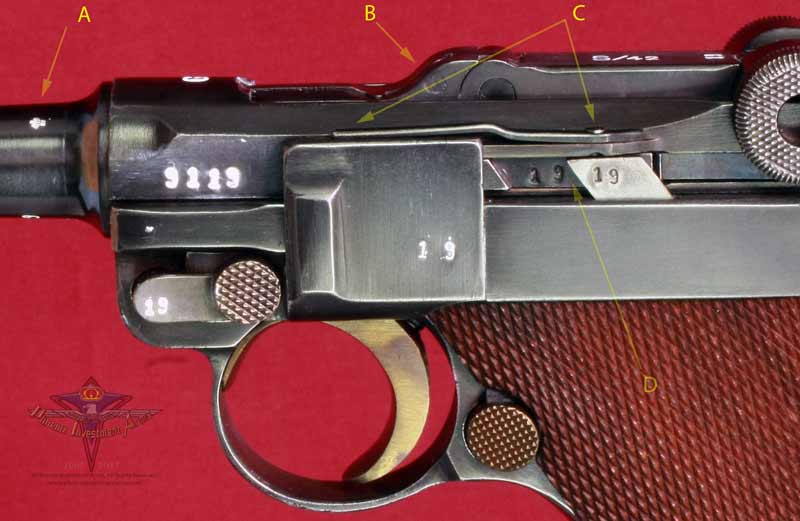 |
|
|
"A" is the Eagle 63 (E63) drooped wing barrel proof; "B" represents the test of the breechbloack (E63). "C" is the Sear Safety, tension loaded so that when the side plate is removed a pin drops into the sear to prevent the gun from firing. Police always carried loaded guns so wxtra safety features were employed to prevent accidents. "D" pointsw to the seriial number on the sear and the sear stop which is a function of the thumb safety. |
|
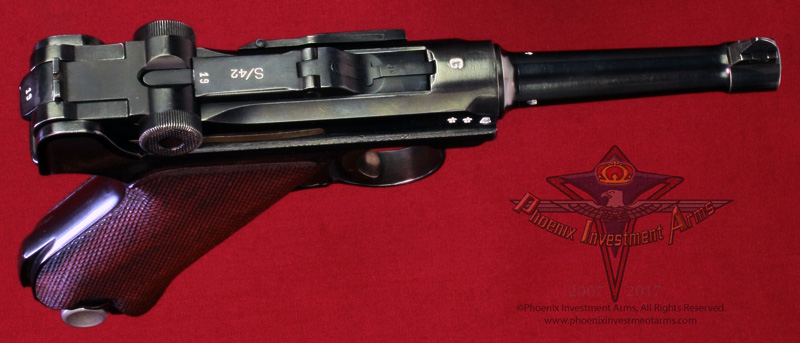 |
|
On the barrel is the drooped wing Eagle 63 from the pressure test and on the back thumb safety you can see the last two digits of the serial number "19". Illustrated is the sear safety which is a small pin that drops down into the sear when the sideplate is removed. |
|
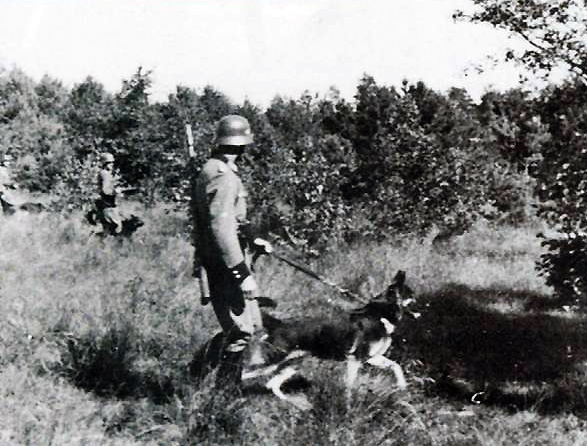 |
|
Sicherheitspolizei: The Sicherheitspolizei (Security Police),
often abbreviated as SiPo, was a term used in
Germany for their security police. In the
Nazi era it was used to describe the state political and
criminal investigation security agencies. It was made up by the
combined forces of the
Gestapo (secret state police) and the (criminal police) between 1936 and 1939. As a formal
agency, the SiPo was folded into the RSHASS-Reichssicherheitshauptamt) in 1939.
The term SiPo was also used to describe security police force
officials (but not the SD members of the RSHA), informally until the
end of the
Third Reich. |
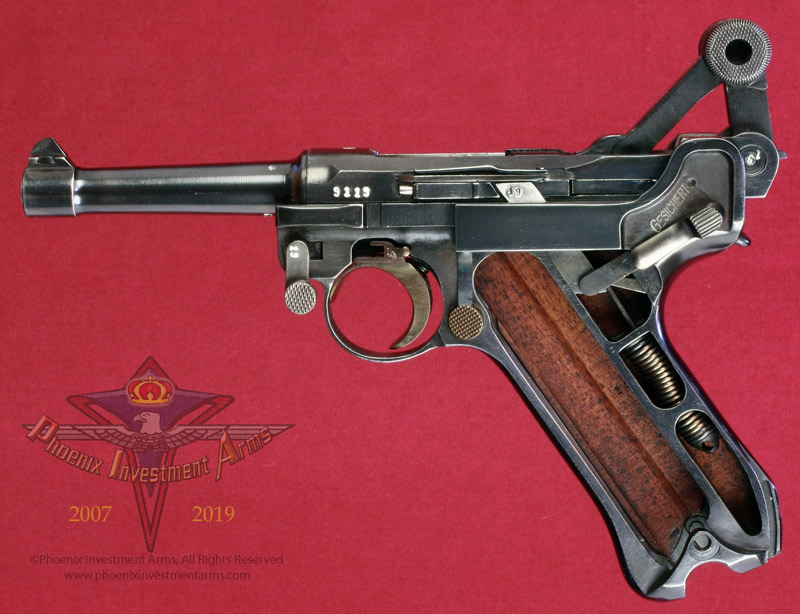 |
|
| Above: The left view with the serial numbered side plate off to reveal the last two digits of the serial number. The pistol shows the minor honest wear of war with shiny points at the high ridges where it came in contact with the holster. In 1932 the Reichswehrministerium issued an order that the rear connecting pin be serial numbered to the gun. You can also see a fine examples of the fire-blued pin. | |
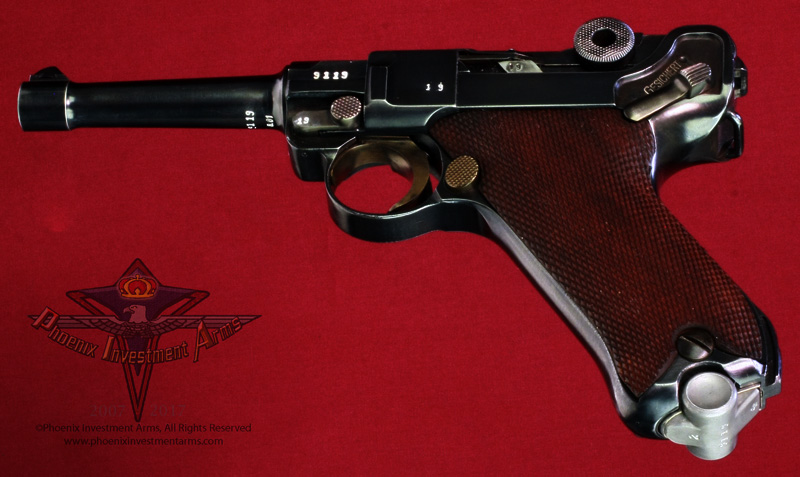 |
|
Above: Above the full serial number appears on the frame, under the barrel on the side of the frame and on the magazines. the last two digits of the serial number appear on the small parts. |
|
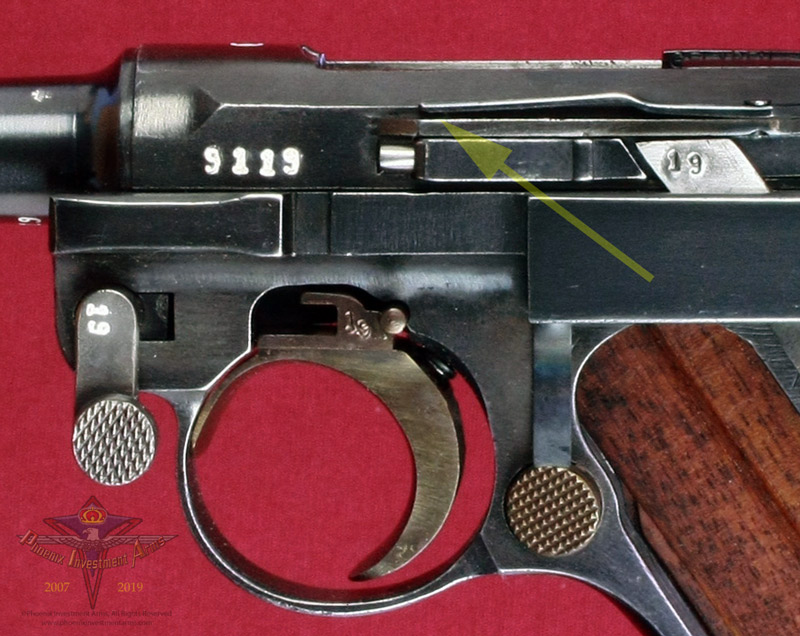 |
|
| SEAR SAFETY: Above - you can see the sear safety
fully installed at the original time of production. This was the
invention of Ludwig Schiwy, a gunsmith and the owner of
F.W.
Vandry &
Company, Berlin. The sear safety consisted of a spring-steel bar on the top of the trigger plate which springs down into a recess in the sear bar, locking the mechanism, if the trigger plate was removed. |
|
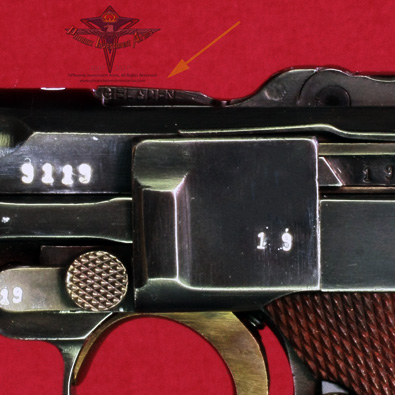 |
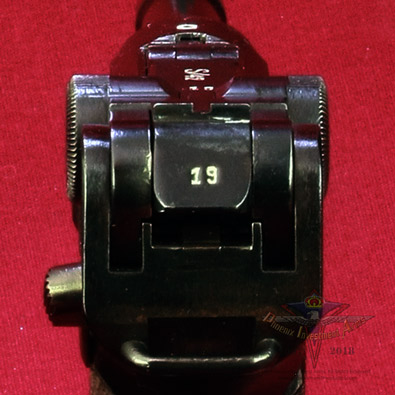 |
| Above Left: Mounted in the breech block is the extractor which is marked on the left side "GELADEN" (Open) | |
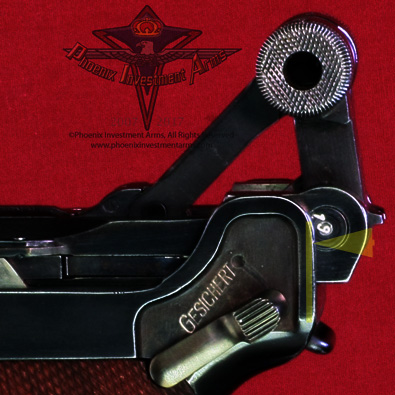 |
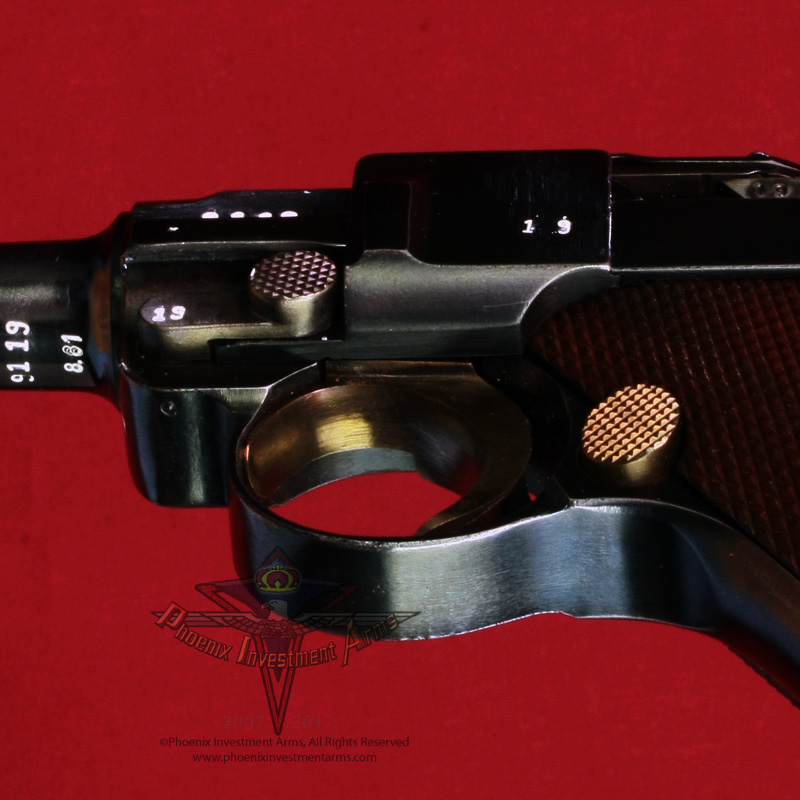 |
In 1932 the Reichswehrministerium
issued an order that the rear connecting pin be serial numbered to the gun
which was required by order in 1933. Therefore we see the last two digits of the serial number "19". The absence of the Mauser manufactured 2mm "hump" at the rear of the frame
indicates this is the classic DWM model frame absorbed by Mauser with the transfer of parts parts from Berlin to Suhl in 1933 Here you can
see all the parts marked with the last two digits of the serial
number plus the Geladen (Loaded) on the Extractor and the
Gesichert (Safe) on the thumb safety. |
|
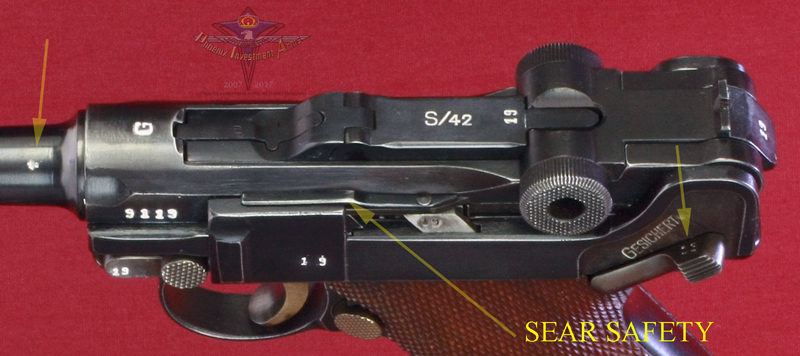 |
|
Note the last two digits of the serial number on the top of the thumb safety. This Parabellum is extremely clean and shows little but holster wear making it an ideal collectible. |
|
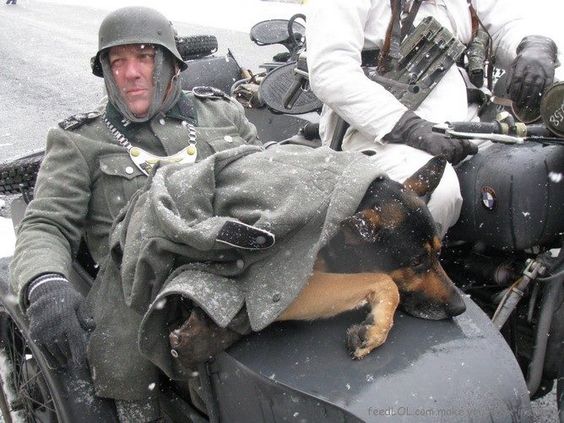 |
|
The SS Police Officer brings a great coat for his dog in the winter in Russia |
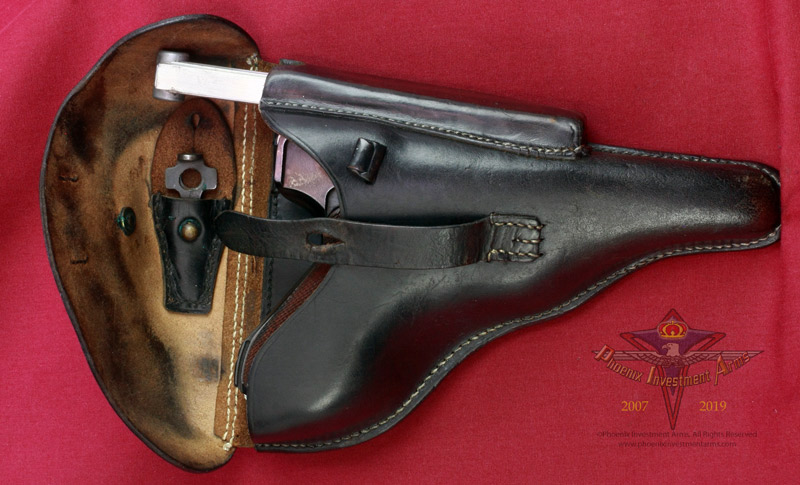 |
|
The inside of
the holster is clean and all the stitching is white and still
functional. Offered with this 41 Mauser byf an all
matching Parabellum that is furnished with a 1941 dated holster, two FXO
magazines, a proofed loading tool. |
|
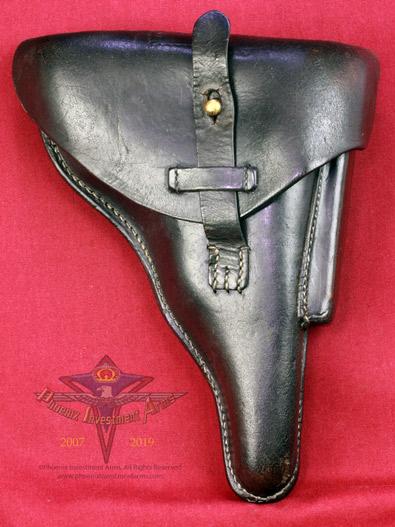 |
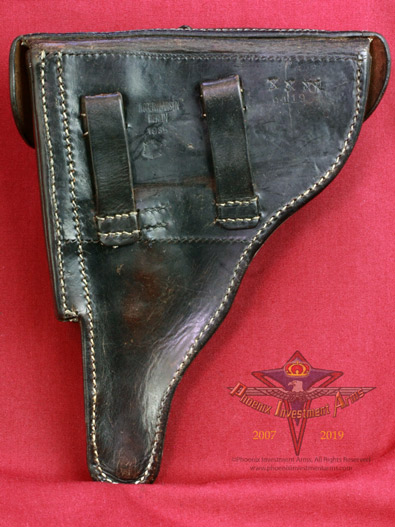 |
Here is the back of the holster with the "41" date and the P08 stamp
along with the Waffen amt acceptance proof. We strive to provide pictures
so you can judge for yourself if the gun meets your criteria. The
leather is in very good condition with all the stitching intact.
All parts of the holster are still pliable and functional. |
|
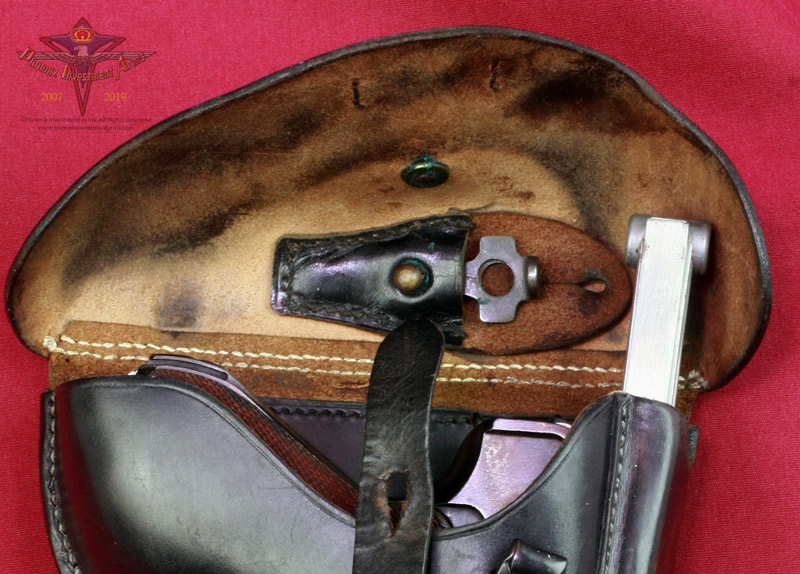 |
|
Above: This is a 1934
dated police holster that is just like new. All the stitching is
intact and the leather is still flexible. Police Holster used the tang and post method of closure to allow a faster draw than the field holster that was a buckle closure. |
|
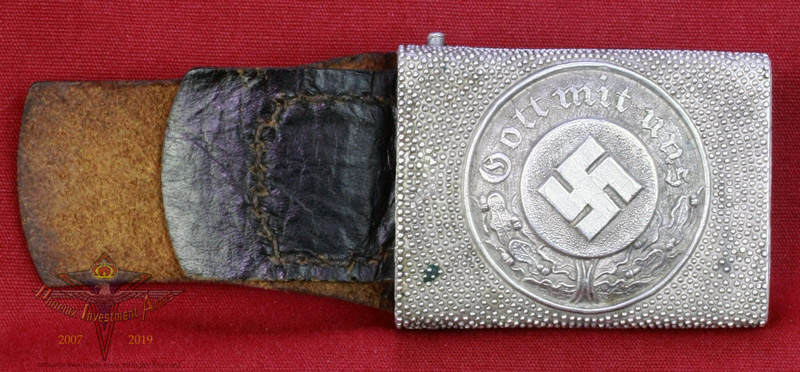 |
|
| A WWII Nazi Police belt buckle. | |
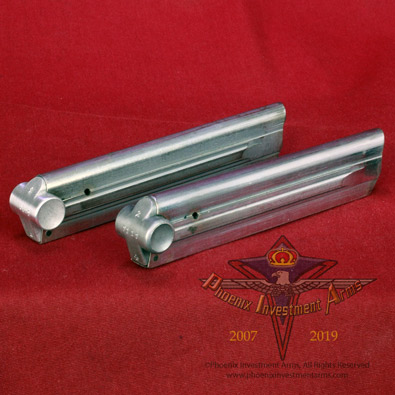 |
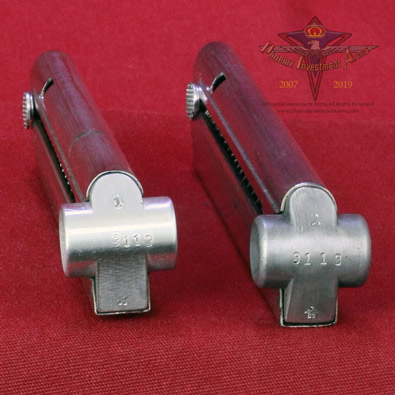 |
Above Are the two extruded magazines that are matching the gun in serial numbers
with one designed by the "2" sign as the second magazine. The belt buckle is the pebble type early style with the chest strap and belt loops. Very unusual to find these rigs in complete, as captured, and in such good condition for a 75 year old Parabellum. |
|
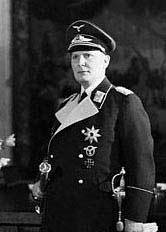 When the Nazis came to power in 1933, Hermann
Göring,
then Prussian minister of the interior, detached the political and
espionage units from the regular Prussian police, filled their ranks with
thousands of Nazis, and, on April 26, 1933, reorganized them under his
personal command as the Gestapo. Simultaneously, Heinrich Himmler, head of
the SS, the Nazi paramilitary corps, together with his aide Reinhardt
Heydrich,
similarly reorganized
the police of Bavaria and the remaining German states. Himmler was given
command over Göring’s
Gestapo in April 1934 and on June 17, 1936, was made German chief of
police with the title of Reichsführer. Nominally under the
Ministry of the Interior, Germany’s police forces now were unified under
Himmler as head of both the SS and the Gestapo. When the Nazis came to power in 1933, Hermann
Göring,
then Prussian minister of the interior, detached the political and
espionage units from the regular Prussian police, filled their ranks with
thousands of Nazis, and, on April 26, 1933, reorganized them under his
personal command as the Gestapo. Simultaneously, Heinrich Himmler, head of
the SS, the Nazi paramilitary corps, together with his aide Reinhardt
Heydrich,
similarly reorganized
the police of Bavaria and the remaining German states. Himmler was given
command over Göring’s
Gestapo in April 1934 and on June 17, 1936, was made German chief of
police with the title of Reichsführer. Nominally under the
Ministry of the Interior, Germany’s police forces now were unified under
Himmler as head of both the SS and the Gestapo. |
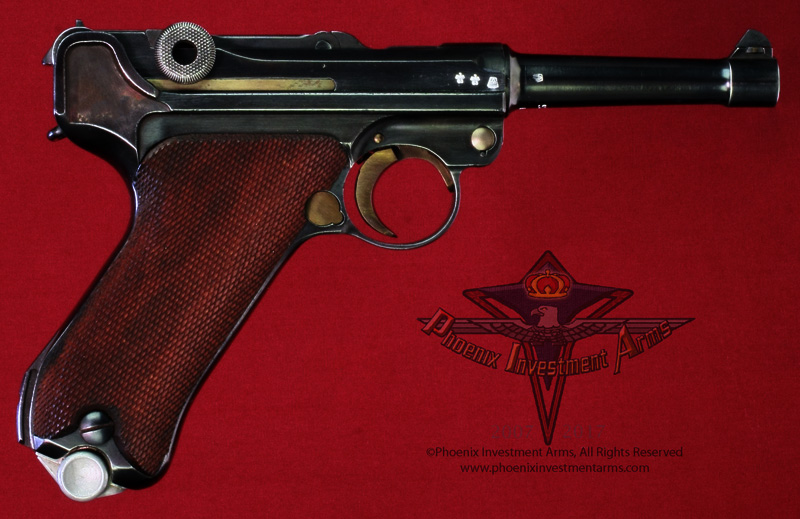 |
|
On the right side of the Parabellum one can see the drooped wing Eagle 63 (E63) twice for the Stage 1 & 2 proofing. Then one can see the German Eagle (Alder) with the resting wings on the frame and on the barrel for final acceptance. |
|
 |
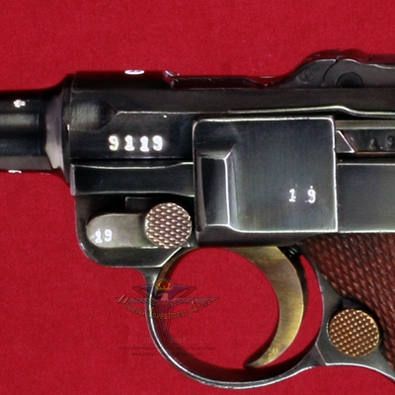 |
Here are closeups to illustrate the early Nazi-era proofs and the extensive numbering that was provided each gun. The pre-war guns were still rust blued until late in 1937 when they speeded the blueing process to a salt blue finish. |
|
 |
|
The Mauser S/42 on the 1st toggle link
and the "S" over thr chamber tells the collector that we have a pre-war 1935 Parabellum only preceded by the "K"-Date (1934) which was produced in limited numbers. |
|
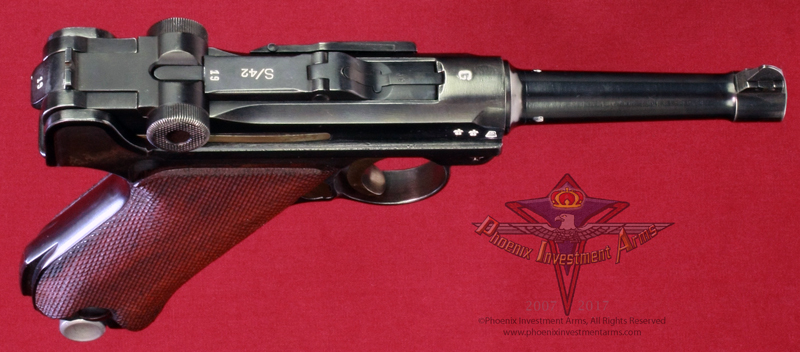 |
|
The absence of tool marks and the high polish makes this a
beautiful example of the craftsmanship of the Mauser gunsmiths. The nice clean and sharp lines on the gun speak to its quality and craftsmanship.
|
|
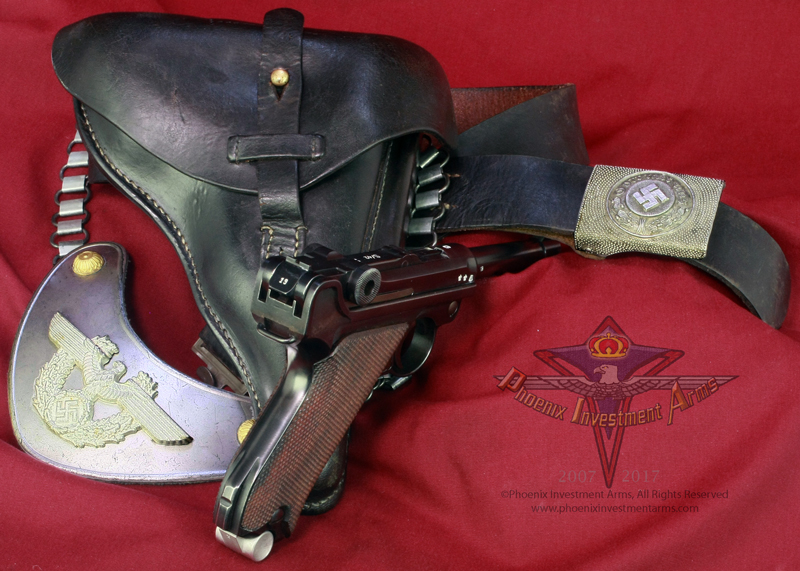 |
|
The police were divided into the Ordnungspolizei (Orpo or regular police) and the Sicherheitspolizei (Sipo or security police). The Orpo assumed duties of regular uniformed law enforcement while the Sipo consisted of the secret state police Geheime-Staatspolizei or Gestapo and criminal investigation police Kriminalpolizei or Kripo. The Gestapo was a corps of professional detectives involved in political police duties and the task of the Kriminalpolizei was fighting crime. On September 1939, the Sipo was combined with the secret service of the SS Sicherheitsdienst (SD) into the Main Office for Security of the Reich the Reichssicherheitshauptamt (RSHA). RSHA symbolize the narrow connection between SS (party organization) and police (state organization). |
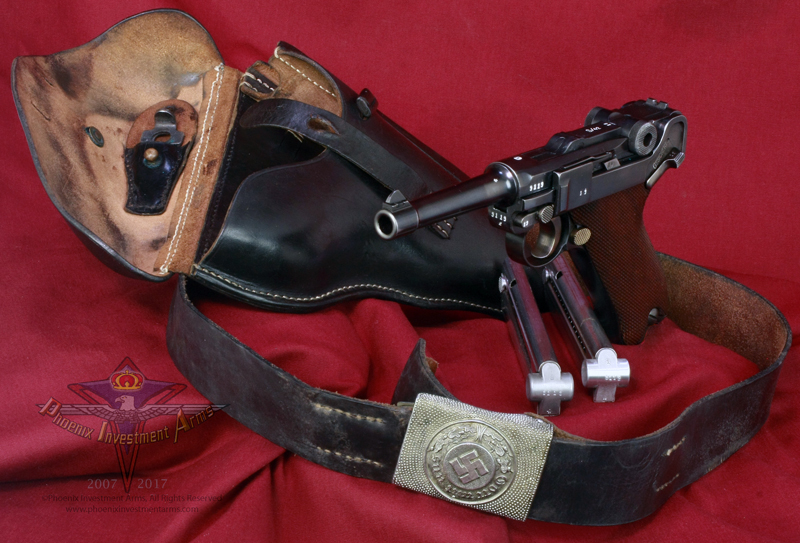 |
|
Open Holster showing the 2nd
matching magazine, the loading tool, holster, belt and police belt
buckle. This is a marvelously preserved Mauser Banner, one of the very
hardest to find for the Police or G-Date collector and great piece for the investor who
wants the best. |
|
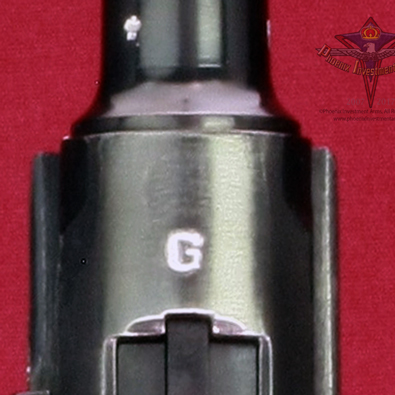 |
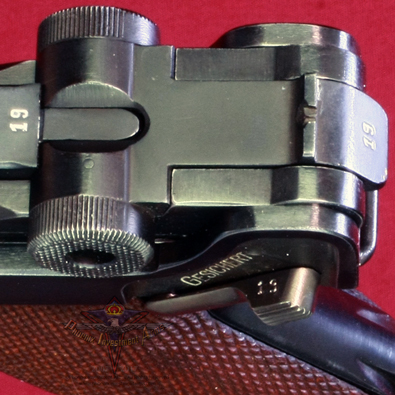 |
Above Right: On the top of the thumb safety we can see the last two digits of the serial number. We highlight the proof marks and lettering with a product called Lacquerstik which enables you to see the lettering & proofs. If you want to remove it down to the "GESCHEIRT" the only factory marked in white use Hoppe's #9 Gun cleaning solvent. |
|
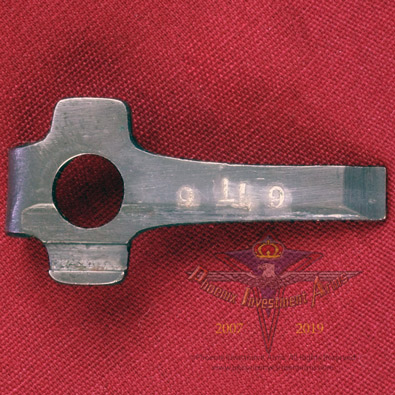 |
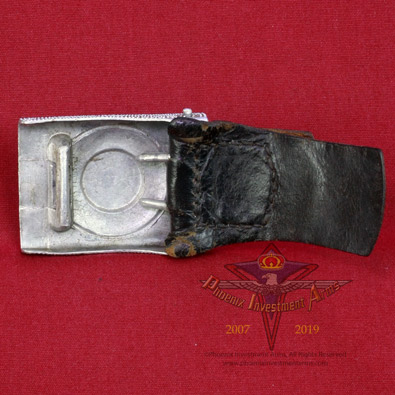 |
Above Left: Here is the loading tool and marked as "police" tools were marked with the serial number on the back and it matches the gun. A jewel found with the same serial numbered holster. Above Right is the back of the buckle with the tab still sewn on. |
|
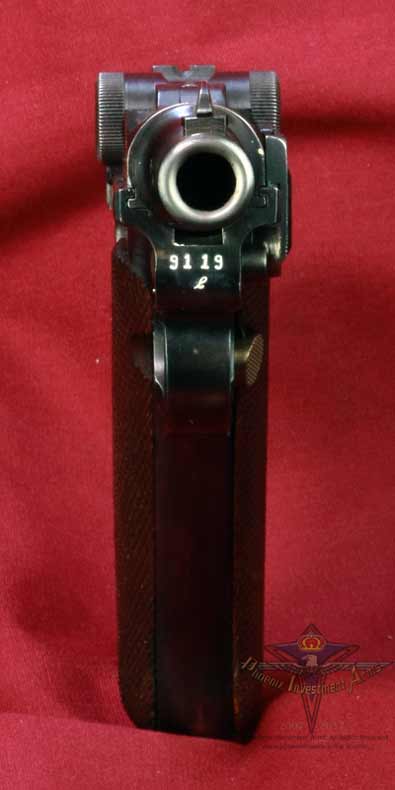 |
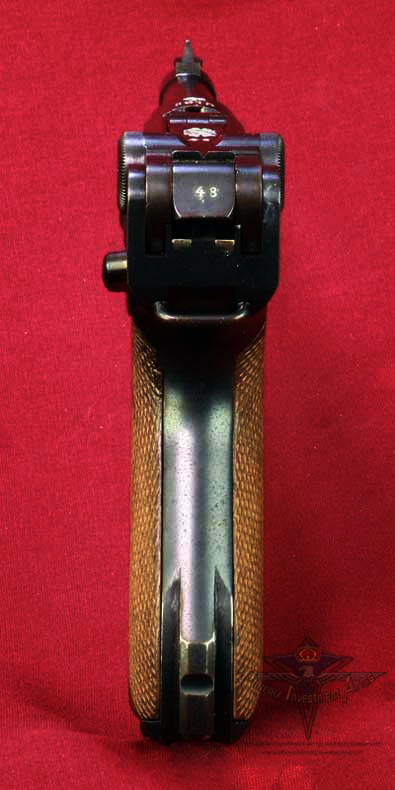 |
The Mauser S/42 on the 1st toggle link
and the "S" over thr chamber tells the collector that we have a pre-war 1935 Parabellum only preceded by the "K"-Date (1934) which was produced in limited numbers. |
|
 |
|
| These are very rarely found and a must have for the Police or the "G"-Date Collector. | |
|
|
|
|
So who was being issued these police type contract guns? By 1942 the police organizations had grown into private armies of various branches. Many of the police organizations were newly created units of Ordnungspolizei (Order Police), these units were issued Parabellum 9mm to SD, Gestapo, Kripo and Einsatzgruppen (anti-Jewish police units). |
|
